You can create stunning jewelry by drawing from global cultural traditions, incorporating symbols like Egyptian Ankhs, Indian lotus motifs, or Native American Thunderbirds that carry deep spiritual meanings. Blend traditional techniques such as Japanese Mokume-gane metal layering or Indian Kundan gemstone setting with contemporary innovations like 3D printing. Use culturally-inspired color palettes and materials like African organic elements or Asian jade to honor heritage while crafting modern pieces that tell meaningful stories spanning continents and centuries.
Understanding Cultural Heritage in Contemporary Jewelry Design
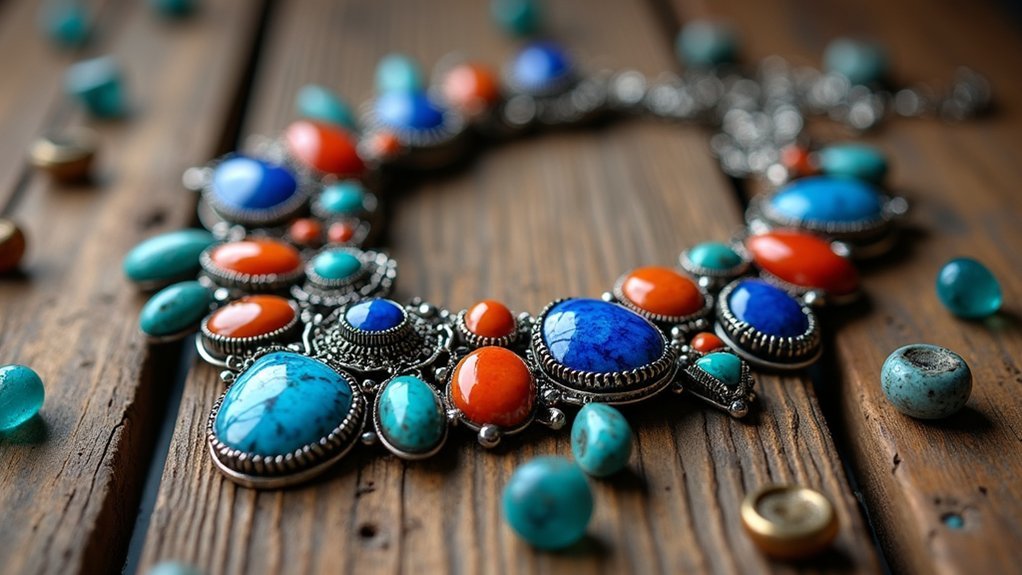
When you explore contemporary jewelry collections today, you’ll discover how modern artisans weave traditional motifs and time-honored techniques from diverse cultures into their creations.
This fusion allows you to connect with cultural heritage through jewelry design that speaks to your identity. You’ll find intricate patterns inspired by global cultures, from Egyptian Ankh symbols to Indian Kundan settings and Chinese dragon engravings.
Contemporary designers skillfully blend these traditional elements with modern aesthetics, creating unique pieces that tell regional stories. When you wear culturally-inspired jewelry, you’re embracing both ancient wisdom and innovative artistry.
These cultural influences transform ordinary accessories into meaningful expressions of heritage, allowing you to celebrate diversity while showcasing sophisticated contemporary style.
Ancient Civilizations and Their Lasting Impact on Modern Pieces
You’ll find that ancient Egyptian jewelry’s sacred symbols like the Ankh and Eye of Horus continue to captivate modern designers who weave these protective motifs into contemporary pieces.
Today’s artisans don’t just copy these ancient designs—they reinterpret them to create jewelry that carries both spiritual significance and modern appeal.
Meanwhile, Roman metalworking techniques, particularly their advanced methods of setting stones and creating intricate chains, still influence how craftspeople approach jewelry construction today.
Egyptian Symbolism in Design
As you explore Egyptian-inspired jewelry, you’ll discover that ancient symbols carry profound meaning that transcends time.
Egyptian symbolism in jewelry design features powerful motifs like the Ankh representing life and the Eye of Horus symbolizing protection. You’ll find scarab beetles embodying rebirth and transformation, reminding you of eternal cycles.
These pieces showcase intricate craftsmanship using gold gemstones that reflect ancient spiritual beliefs and advanced metalworking techniques. Hieroglyphics and inscriptions convey messages of power and devotion, demonstrating cultural expression through written language.
Today’s artisans draw from these timeless symbols, creating contemporary pieces that honor heritage while appealing to modern aesthetics, proving Egyptian influence remains relevant in current jewelry design.
Roman Techniques Today
Moving beyond Egypt’s symbolic richness, Roman civilization contributed equally transformative innovations to jewelry craftsmanship that continue shaping today’s designs.
You’ll find cultural influences evident in Roman jewelry design’s intricate techniques like granulation and filigree, which modern artisans still employ for detailed textures. These ancient craftsmen established gold and precious gemstones as status symbols, directly inspiring today’s luxury pieces.
Roman intaglio and cameo work pioneered storytelling through imagery on engraved stones, a practice you’ll see throughout contemporary collections.
Their simple bangles and rings influenced modern minimalist designs emphasizing clean lines. Roman clasp innovations revolutionized wearability, leading to today’s advanced functionality and design aesthetics that seamlessly blend practicality with beauty in modern designs.
Traditional Symbolism and Sacred Motifs in Global Jewelry
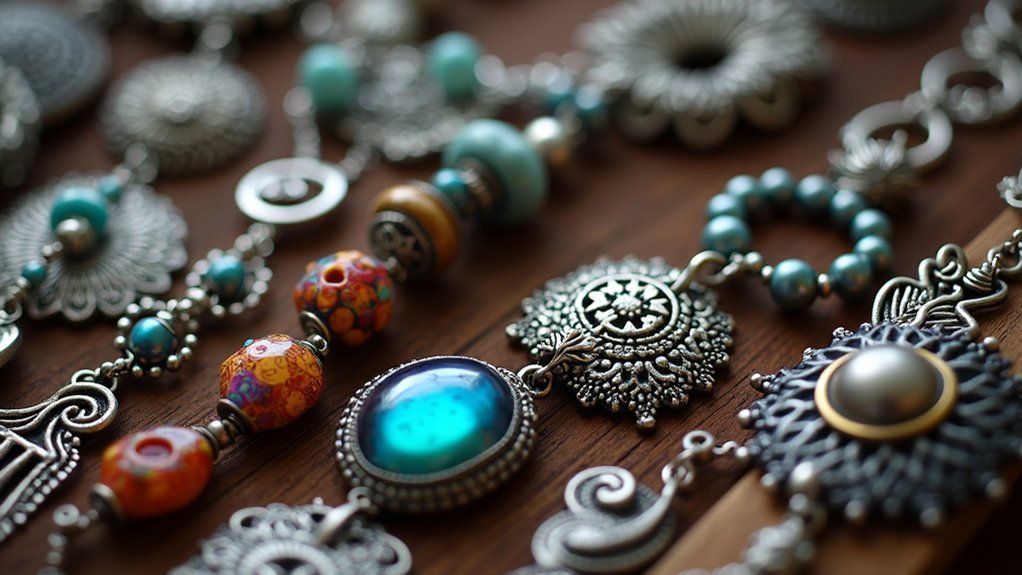
You’ll find that jewelry across cultures carries profound spiritual meanings, from the protective Thunderbird symbols in Native American pieces to the purity represented by lotus motifs in Indian designs.
These sacred symbols aren’t just decorative—they’re powerful talismans that connect you to ancient beliefs about protection, strength, and spiritual guidance.
Whether it’s the marital commitment symbolized by a mangalsutra or the ancestral protection offered by African amulets, you’re wearing centuries of cultural wisdom when you choose pieces with traditional motifs.
Ancient Sacred Symbol Meanings
Sacred symbols carved into ancient jewelry tell stories that transcend time, carrying profound spiritual meanings across civilizations.
You’ll discover that cultural influences shape these timeless designs, where jewelry reflects humanity’s deepest beliefs and aspirations.
The lotus flower in Indian jewelry represents purity and spiritual enlightenment, creating a deep spiritual connection between wearer and divine.
Chinese dragon motifs in jewelry embody power and good fortune, while Egypt’s Ankh symbolizes eternal life.
Ancient symbols representing fertility appear throughout African traditions, where motifs like the cowrie shell signify wealth and abundance.
The dreamcatcher in Native American jewelry filters negative energy, serving protective purposes beyond decoration.
These rich narratives that accompany traditional motifs demonstrate how sacred symbolism transforms simple adornments into powerful spiritual tools.
Cross-Cultural Protective Motifs
Across diverse civilizations, protective motifs in jewelry serve as universal guardians that transcend geographical boundaries and cultural differences.
You’ll discover cross-cultural protective motifs like Egypt’s Eye of Horus and the Middle Eastern Hamsa hand warding off evil. Native American jewelry showcases the Thunderbird’s spiritual connections to nature’s protective forces.
In Hindu culture, the mangalsutra safeguards married women from negative energies while symbolizing commitment.
African tribal jewelry incorporates cowrie shells representing wealth and ceremonial protection.
These symbols demonstrate humanity’s shared desire for spiritual safeguarding through adornment. The serpent motif appears across civilizations, embodying transformation and renewal in jewelry designs.
When you create culturally-inspired pieces, you’re connecting with ancient protective traditions that continue resonating across modern global communities, honoring timeless spiritual beliefs.
Regional Craftsmanship Techniques Across Continents
When you examine jewelry from different continents, you’ll discover that each region has developed distinctive techniques that reflect both available materials and cultural values.
These craftsmanship methods showcase centuries of refined artistry and cultural storytelling.
These time-honored techniques preserve ancient wisdom while telling the profound stories of diverse cultures through precious metals and stones.
- African artisans create stunning pieces using organic materials like seeds, shells, and beads, reflecting their natural environment and heritage.
- Japanese Mokume-gane involves layering different metals to produce unique patterns, demonstrating masterful metalworking skills passed down through generations.
- Indian Kundan technique sets gemstones in gold foil, combining intricate metalwork with vibrant colors that capture India’s rich cultural essence.
- Native American silversmithing incorporates spiritual symbols like the Thunderbird, while European filigree work features delicate wire-twisting techniques.
Each tradition represents distinct approaches to jewelry making that you can incorporate into contemporary designs.
Eastern Aesthetics: Asian Influences in Contemporary Collections
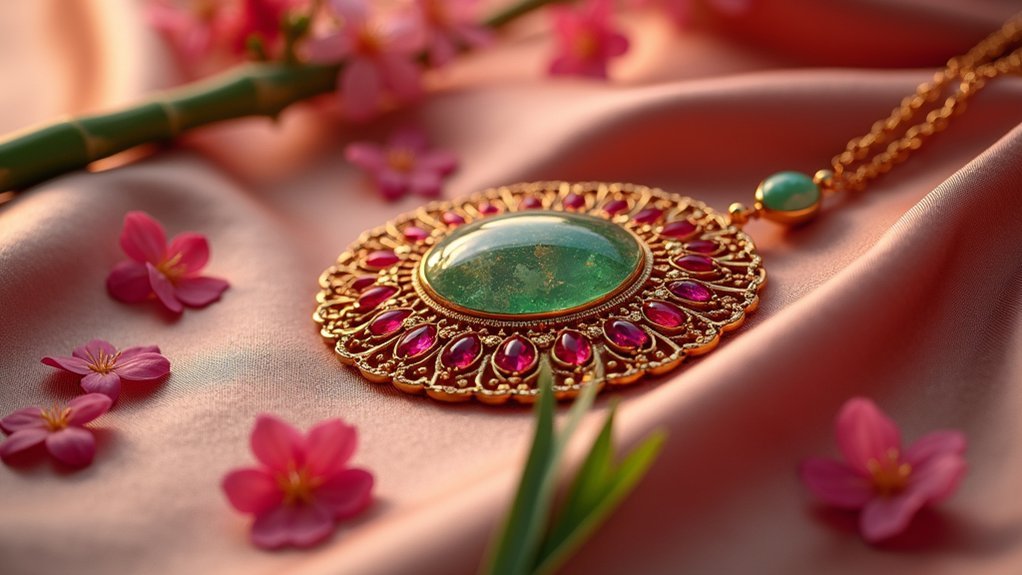
How do contemporary jewelry designers capture the ethereal beauty of Eastern aesthetics while honoring centuries-old traditions?
You’ll discover they masterfully blend intricate craftsmanship techniques like Japanese Mokume-gane, creating distinctive layered metal patterns that showcase traditional artistry.
When you examine these pieces, you’ll notice auspicious symbols—dragons representing power and lotus flowers symbolizing purity—that carry deep cultural significance.
Indian Kundan designs inspire modern collections where vibrant gemstones merge traditional artistry with contemporary aesthetics.
You’ll see how Eastern principles of balance and harmony manifest through symmetrical designs and flowing forms.
Natural materials like jade enhance each piece’s narrative, connecting you to centuries of cultural meaning while embracing modern sensibilities.
African Tribal Elements in Modern Jewelry Expressions
Moving from Asia’s refined minimalism, African jewelry brings bold geometric patterns and vibrant colors that celebrate the continent’s rich cultural tapestry.
You’ll discover how contemporary designers blend traditional craftsmanship with modern techniques to create stunning pieces that honor ancestral wisdom.
These tribal motifs carry deep cultural narratives through:
- Seeds, shells, and metals that connect you to authentic African artisanship
- Symbols representing strength, protection, and identity from diverse tribes
- Innovative expressions that preserve traditional essence while embracing contemporary style
- Ethical sourcing and fair-trade practices that empower local communities
When you choose African-inspired jewelry, you’re not just wearing beautiful accessories—you’re supporting sustainable practices and connecting with powerful stories.
Today’s socially conscious brands guarantee your purchase celebrates both artistic heritage and responsible craftsmanship.
European Art Movements Shaping Current Design Trends
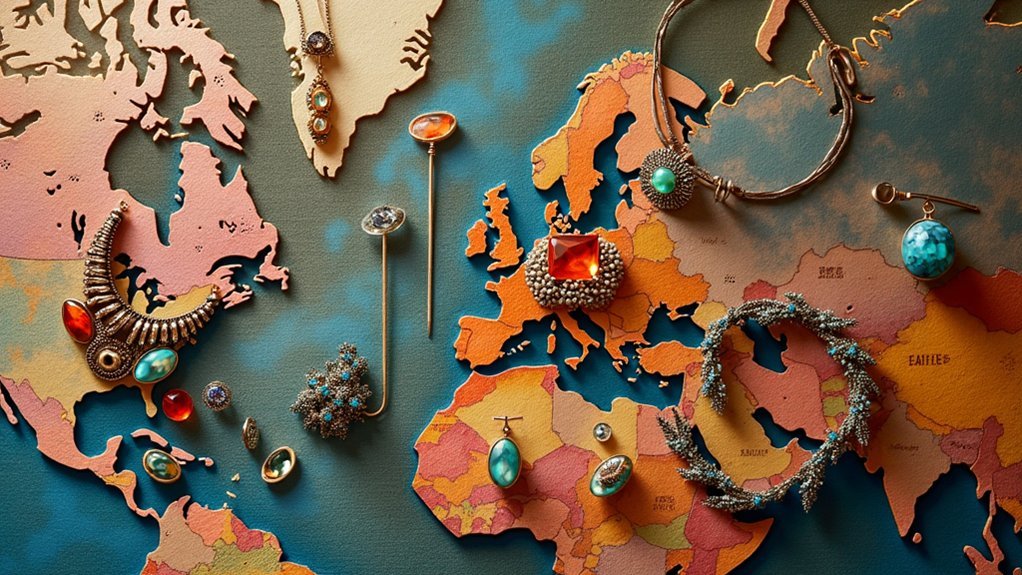
You’ll find that European art movements have profoundly shaped today’s jewelry aesthetics, with Art Nouveau’s flowing botanical forms creating pieces that mirror nature’s organic beauty.
Bauhaus’s revolutionary approach brings you clean, geometric designs that strip away ornamentation to reveal pure structural elegance.
These contrasting philosophies—one celebrating nature’s curves, the other embracing mathematical precision—offer you distinctly different yet equally compelling design languages in contemporary jewelry.
Art Nouveau’s Natural Motifs
Whispers of leaves and petals dance through Art Nouveau jewelry, where nature’s organic forms transformed late 19th-century design into something revolutionary.
You’ll discover how this movement embraced natural motifs, creating intricate designs that celebrated craftsmanship above all else.
René Lalique and his contemporaries drew inspiration from:
- Floral designs featuring flowing vines, roses, and iris petals
- Symbolic creatures like dragonflies and peacocks rendered in delicate detail
- Innovative materials combining gemstones with enamel and glass inlays
- Organic forms that mimicked nature’s curves and asymmetrical beauty
Today’s contemporary jewelry continues this legacy, where artisanal craftsmanship honors Art Nouveau’s dedication to harmony between human creativity and natural beauty.
You’re witnessing how these timeless motifs inspire modern artisans worldwide.
Bauhaus Minimalist Geometric Forms
While Art Nouveau celebrated nature’s flowing curves, the Bauhaus movement stripped jewelry down to its geometric essence, creating designs that championed form following function.
You’ll find this German movement, founded in 1919, revolutionized jewelry design by merging artistry with industrial materials like metal and glass. The minimalist approach emphasized geometric shapes and clean lines, proving that simplicity doesn’t sacrifice artistic value.
Today’s modern jewelry reflects this powerful legacy through sustainable craftsmanship and ethical production methods. You can see Bauhaus inspiration in contemporary pieces that prioritize material purity and functional aesthetics.
Designers like Marcel Breuer and Gunta Stölzl challenged traditional adornment concepts, creating a design philosophy that continues influencing today’s minimalist trends toward purposeful, beautiful jewelry.
Indigenous Artistry and Native Cultural Representations
When you explore indigenous jewelry traditions, you’re encountering art forms that transcend mere decoration to become powerful vessels of cultural storytelling and spiritual significance.
Indigenous artistry transforms natural materials into meaningful expressions of cultural heritage through traditional techniques passed down for generations.
Ancient wisdom flows through skilled hands, transforming earth’s gifts into sacred vessels that carry the heartbeat of generations forward.
Contemporary artists blend ancestral craftsmanship with modern aesthetics, creating jewelry design that celebrates cultural identity while reaching global audiences.
You’ll discover how these pieces maintain their authentic spiritual significance:
- Symbols like the Thunderbird represent protection and strength in ceremonial contexts
- Local stones, bones, and metals reflect deep environmental connections
- Beadwork and metal smithing preserve unique cultural practices
- Ritual pieces like dreamcatchers serve specific ceremonial purposes
This artistry demonstrates how traditional techniques continue evolving while honoring ancestral wisdom.
Fusion Approaches: Blending Multiple Cultural Elements
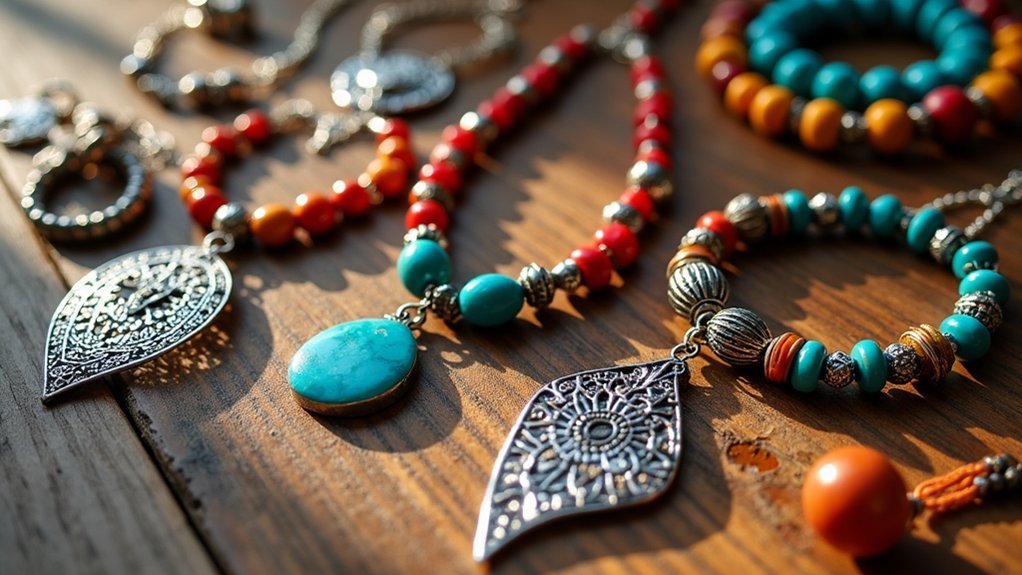
As contemporary jewelry artisans embrace cultural fusion, they’re creating extraordinary pieces that weave together diverse traditions into cohesive artistic statements. You’ll discover how cultural influences in jewelry transform when designers blend traditional aesthetics from multiple heritage sources. This fusion of gold with diverse cultural influences produces intricate detailing that honors ancestral craftsmanship while appealing to modern sensibilities.
| Cultural Combination | Materials Used | Design Elements |
|---|---|---|
| Indian-Scandinavian | Kundan, minimalist metals | Geometric patterns, precious stones |
| African-Asian | Traditional beads, silk threads | Vibrant colors, textural contrast |
| Native-Japanese | Natural fibers, cherry wood | Dreamcatchers, floral motifs |
| Celtic-Moroccan | Silver wire, amber | Knotwork, geometric tiles |
| Aztec-Mediterranean | Turquoise, coral | Sun symbols, wave patterns |
You’ll find sustainability and ethical sourcing create spiritual connection to nature. Jewelry design holds endless possibilities when enchanting art emerges from respectful cultural fusion.
Materials and Gemstones From Different Geographic Regions
The earth’s diverse landscapes have gifted jewelry makers with an extraordinary palette of materials, each carrying the geological fingerprint of its origin.
When you’re exploring global inspiration for jewelry design, you’ll discover how geological diversity shapes regional traditions and artisanal practices.
Different continents offer distinct materials and gemstones that reflect their rich cultural heritage:
- African sources provide colorful beads, bone, and wood from abundant natural resources
- Indian traditions showcase precious and semi-precious gemstones through intricate metalwork techniques like Kundan
- South American regions feature Andean silver with vibrant turquoise and lapis lazuli
- Middle Eastern artisanal traditions emphasize opulent materials including gold and pearls
Each region’s geological gifts create unique aesthetic signatures, allowing you to incorporate authentic cultural elements into contemporary designs.
Color Palettes Inspired by Cultural Traditions Worldwide
Beyond the raw materials themselves, cultural color palettes tell profound stories of heritage, belief systems, and regional identity that you can weave into your jewelry designs.
You’ll find vibrant colors like India’s reds and golds symbolizing wealth, while African traditions showcase earthy tones reflecting rich landscapes.
Chinese culture treasures jade’s green hues for purity and protection, and Mexican artisans celebrate bright turquoise and coral expressing artistic vibrancy.
Jade’s protective green and vibrant turquoise coral showcase how different cultures infuse profound meaning into their treasured color palettes.
Middle Eastern designs feature deep blues with rich golds, echoing historic trade route opulence.
These intricate patterns and symbolism from global inspiration create unique styles that honor rich cultural heritage.
When you incorporate these traditional color schemes, you’re not just creating jewelry—you’re preserving cultural traditions through contemporary craftsmanship.
Contemporary Interpretations of Historical Jewelry Styles
When modern jewelry designers reshape centuries-old traditions, they’re creating pieces that bridge ancient craftsmanship with today’s aesthetic sensibilities.
You’ll find contemporary artists drawing from global cultures to reimagine historical styles with fresh perspectives.
These modern interpretations showcase remarkable artistic skills while honoring cultural diversity:
- Spanish filigree techniques merge with minimalist designs, creating delicate yet bold statement pieces
- Indian Kundan settings incorporate vibrant gemstones into sleek, contemporary frameworks that maintain traditional aesthetics
- Ancient symbols like Chinese dragons and Native American dreamcatchers appear in refined, modern contexts
- African geometric patterns transform into sophisticated designs using cutting-edge technology
Through 3D printing and laser cutting, you’re witnessing intricate patterns achieve new precision levels.
This fusion of jewelry design traditions creates meaningful pieces that celebrate heritage while embracing innovation.
Sustainable Practices in Culturally-Inspired Jewelry Making
As contemporary jewelry designers embrace cultural inspiration, they’re simultaneously revolutionizing their practices through sustainable methods that honor both heritage and environmental responsibility.
You’ll find they’re prioritizing ethically sourced materials like recycled metals and conflict-free gemstones to minimize environmental impact while supporting fair labor practices.
Modern techniques including 3D printing and laser cutting help you achieve intricate culturally-inspired designs while reducing waste, perfectly blending traditional craftsmanship with innovation.
Technology meets tradition as contemporary jewelry makers merge cutting-edge tools with ancestral techniques to create sustainable, culturally-rich designs.
When you choose local materials, you’re supporting community economies and connecting authentically with cultural roots.
Fair-trade certification guarantees artisans receive proper compensation for their work.
You can also incorporate biodegradable materials such as organic beads and sustainably harvested woods, creating pieces that honor both cultural traditions and environmental stewardship through thoughtful sustainable practices.
Frequently Asked Questions
What Culture Did Jewelry Come From?
You can’t pinpoint jewelry’s origin to one culture since it emerged independently across ancient civilizations. You’ll find early examples from Africa, Mesopotamia, Egypt, and Asia, each developing unique styles and techniques simultaneously.
How Do I Get Inspiration for Jewellery Design?
You’ll find inspiration by studying nature’s patterns, exploring historical designs, visiting museums, observing street fashion, experimenting with materials, sketching daily, traveling to experience different cultures, and collecting vintage pieces that spark creativity.
Why Do Different Cultures Wear Different Jewelry?
Different cultures wear distinct jewelry because you’re expressing your unique identity, beliefs, and traditions. Each piece carries specific cultural narratives – like mangalsutras symbolizing marriage or Thunderbird designs representing protection in your community.
Which Culture Wears the Most Jewelry?
You’ll find Indian culture typically wears the most jewelry, especially during weddings where brides don multiple kilograms of gold pieces. However, you can’t definitively rank cultures since jewelry usage varies considerably by occasion and region.
In Summary
You’ve discovered how cultural influences can transform your jewelry designs into meaningful expressions of global heritage. By incorporating ancient symbols, traditional techniques, and regional materials, you’re creating pieces that honor diverse cultures while speaking to contemporary audiences. Remember to approach cultural elements respectfully, research their significance thoroughly, and prioritize sustainable practices. Your jewelry becomes a bridge between past and present, connecting wearers to the rich tapestry of human creativity and tradition.

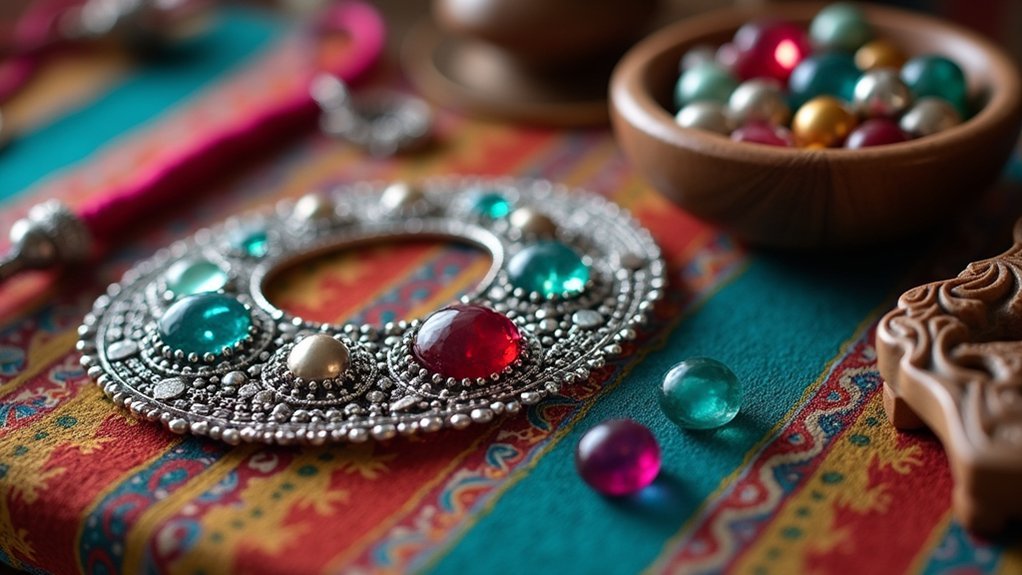
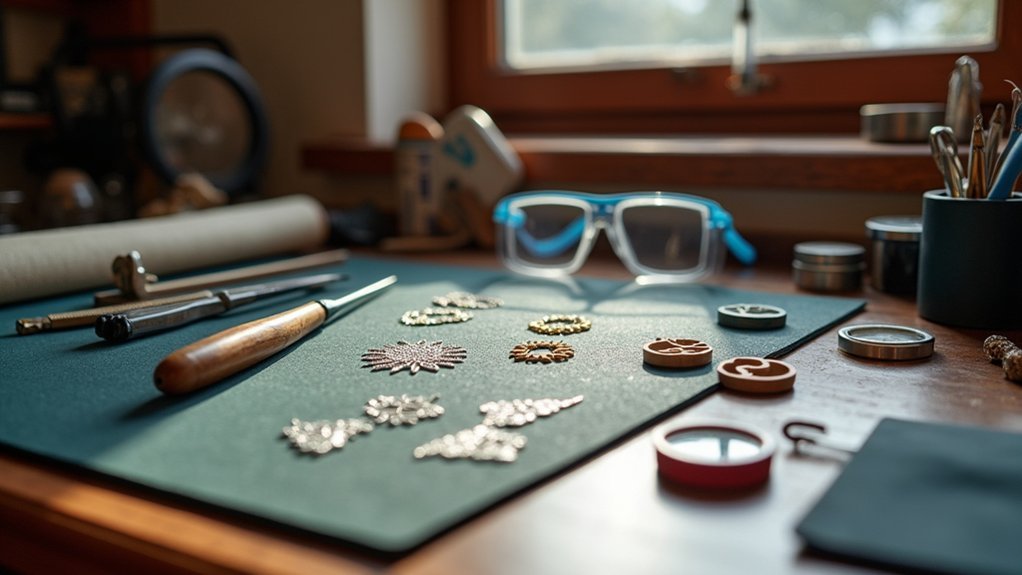
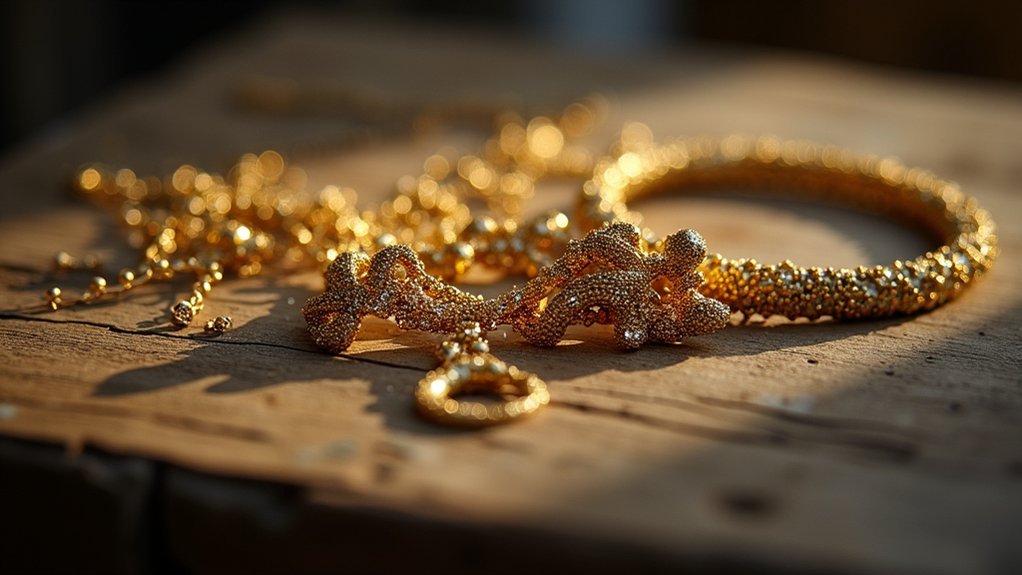
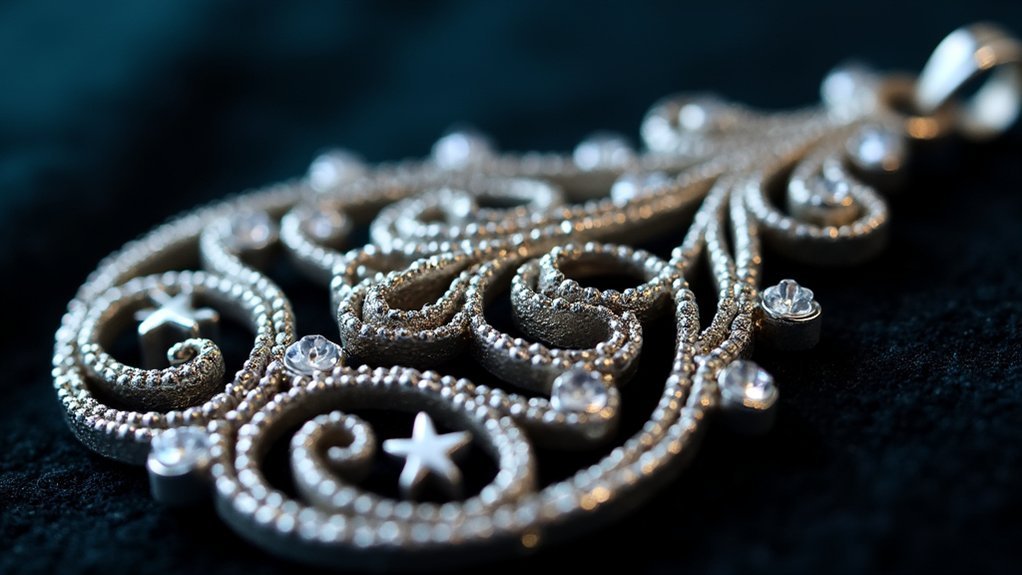
Leave a Reply